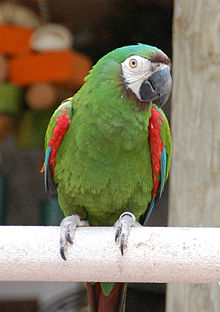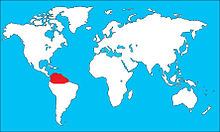- Chestnut-fronted Macaw
-
Chestnut-fronted Macaw 
At Southwick's Zoo, Massachusetts, USA Conservation status Scientific classification Kingdom: Animalia Phylum: Chordata Class: Aves Order: Psittaciformes Family: Psittacidae Subfamily: Psittacinae Tribe: Arini Genus: Ara Species: A. severus Binomial name Ara severus
(Linnaeus, 1758)subspecies A. s. severus
A. s. castaneifrons
Red area is range The Chestnut-fronted Macaw or Severe Macaw (Ara severus) is one of the largest of the Mini-Macaws. It reaches a size of around 45 cm (18 in) of which around half is the length of the tail.
They can be found over a large part of Northern South America from Panama south into Amazonian Brazil and northern Bolivia.
Their lifespan is listed as anything from 30 to 80 years of age.
Contents
Description
The Chestnut-fronted or Severe Macaw is mostly green in colour with patches of red and blue on the wings. The head has a Chestnut brown patch just above the beak. The beak is black and the patches around the eyes are white with lines of small black feathers. It is the only one of the miniature macaws that has lines of feathers in the bare patches around its eyes. In the wild their typically gregarious personality can become more aggressive at puberty giving them the name Severe. This tendency can be curbed in captivity but the species requires significant handling to make a tame pet. It is 45-50 cm (18-20 in) long and weighs 300-410 grams (10.6-14.5 oz.)
Breeding
The Chestnut-fronted Macaw nest in a hole in a tree. The eggs are white and there are usually two or three in a clutch. The female incubates the eggs for about 28 days, and the chicks fledge from the nest about 70 days after hatching.[1]
References
- ^ Alderton, David (2003). The Ultimate Encyclopedia of Caged and Aviary Birds. London, England: Hermes House. p. 236. ISBN 1-84309-164-X.
- BirdLife International (2008). Ara severus. 2006. IUCN Red List of Threatened Species. IUCN 2006. www.iucnredlist.org. Retrieved on 5 January 2008. Database entry includes justification for why this species is of least concern
External links
- Severe Macaw at Animal-World
- Chestnut-fronted Macaw photo gallery at Visual Resources for Ornithology
- Chestnut-fronted Macaw videos in the Internet Bird Collection
- Stamps (for Bolivia, Ecuador, Guyana, Panama, Peru, Suriname) with (inaccurate)-RangeMap
- Chestnut-fronted Macaw - Wild Perched Pair (medium res photo) and Article - "Amazonia Lodge" at Pinkmoose Birding
- Chestnut-fronted Macaw (high res photo) at Bird Watcher's Digest
- Chestnut-fronted Macaw (Ara severus) - Species Factsheet at BirdLife International
Macaws Genus Species (extinctions: † indicates a species confirmed to be extinct, ₴ indicates evidence only from sub-fossils)Anodorhynchus Cyanopsitta Ara Blue-and-yellow Macaw (or Blue-and-gold Macaw) • Blue-throated Macaw • Military Macaw • Great Green Macaw (or Buffon's Macaw) • Scarlet Macaw • Red-and-green Macaw (or Green-winged Macaw) • Red-fronted Macaw • Chestnut-fronted Macaw (or Severe Macaw) • Cuban Red Macaw † • Saint Croix Macaw † ₴Orthopsittaca Primolius Diopsittaca Hypothetical extinct macaws
(unconfirmed genus)
This article relating to parrots is a stub. You can help Wikipedia by expanding it.


